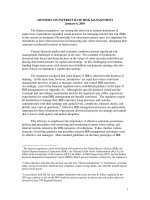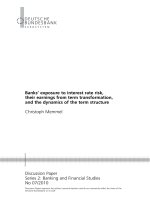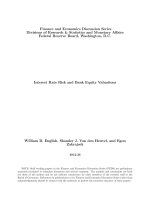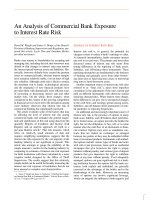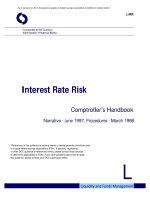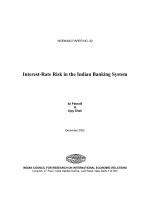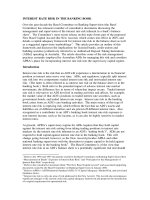Interest rate risk management
Bạn đang xem bản rút gọn của tài liệu. Xem và tải ngay bản đầy đủ của tài liệu tại đây (525.57 KB, 135 trang )
An Investigation into the
Management of Interest Rate Risk
in Large UK Companies
Christine Helliar1, Alpa Dhanani2, Suzanne Fifield1 and
Lorna Stevenson1
1University
2University
of Dundee
of Cardiff
AMSTERDAM • BOSTON • HEIDELBERG • LONDON
NEW YORK • OXFORD • PARIS • SAN DIEGO
SAN FRANCISCO • SINGAPORE • SYDNEY • TOKYO
CIMA Publishing is an imprint of Elsevier
CIMA Publishing
An imprint of Elsevier
Linacre House, Jordan Hill, Oxford OX2 8DP
30 Corporate Drive, Burlington, MA 01803
First published 2005
Copyright © 2005, Christine Helliar, Alpa Dhanani, Suzanne Fifield and Lorna Stevenson.
All rights reserved
The rights of Christine Helliar, Alpa Dhanani, Suzanne Fifield and Lorna Stevenson to be
identified as the authors of this work has been asserted in accordance with the Copyright,
Designs and Patents Act 1988
No part of this publication may be reproduced in any material form (including
photocopying or storing in any medium by electronic means and whether
or not transiently or incidentally to some other use of this publication) without
the written permission of the copyright holder except in accordance with the provisions
of the Copyright, Designs and Patents Act 1988 or under the terms of a licence issued by the
Copyright Licensing Agency Ltd, 90 Tottenham Court Road, London, England
W1T 4LP. Applications for the copyright holder’s written permission to reproduce any
part of this publication should be addressed to the publisher
Permissions may be sought directly from Elsevier’s Science and Technology Rights
Department in Oxford, UK: phone: (ϩ44) (0) 1865 843830; fax: (ϩ44) (0) 1865 853333;
e-mail: You may also complete your request on-line via
the Elsevier homepage (), by selecting ‘Customer Support’ and
then ‘Obtaining Permissions’
British Library Cataloguing in Publication Data
A catalogue record for this book is available from the British Library
Library of Congress Cataloguing in Publication Data
A catalogue record for this book is available from the Library of Congress
ISBN
0 7506 6598 x
For information on all CIMA Publishing Publications
visit our website at www.cimapublishing.com
Typeset by Integra Software Services Pvt. Ltd, Pondicherry, India
www.integra-india.com
Printed and bound in Great Britain
Working together to grow
libraries in developing countries
www.elsevier.com | www.bookaid.org | www.sabre.org
Contents
Acknowledgements
v
Executive Summary
vi
1
1
3
3
4
6
7
Interest Rate Risk Management
1.1
1.2
1.3
1.4
1.5
2
Literature Review
2.5
2.6
2.7
2.8
2.9
2.10
2.11
2.12
2.13
Research Method
3.1
3.2
3.3
3.4
3.5
4
Introduction
Risk and uncertainty
Defining arbitrage, hedging and speculation
The rationale for corporate risk management
and hedging
Interest rate and foreign exchange risk management
Interest rate risk
Derivatives usage: Evidence from prior empirical
research
Interest rate risk management
Corporate governance and the disclosure of risk
Accounting for financial instruments
Hedge accounting
FRED 23 and FRED 30
Summary
Introduction
Interviews
Questionnaires
Analysis of the questionnaire responses
Summary
Interview Findings
4.1
4.2
4.3
4.4
Introduction
The importance of interest rate risk
Factors affecting interest rate risk
Forecasting and the use of specialists
9
11
12
13
15
17
18
21
25
27
30
34
35
36
39
41
41
42
45
45
47
49
49
50
55
Contents
2.1
2.2
2.3
2.4
3
Introduction
Risk
Interest rate risk
Interest rate risk management and derivatives usage
Summary
iii
4.5
4.6
4.7
4.8
5
Questionnaire Survey
Contents
5.1
5.2
5.3
5.4
5.5
5.6
5.7
5.8
5.9
iv
5.10
5.11
5.12
5.13
6
The use of derivatives for interest rate risk management
Corporate governance: Monitoring, reporting
and control
The impact of accounting standards on
interest rate risk management
Summary
Introduction
Background information
Interest rate risk policy
The debt and funding structure
Forecasting
Factors affecting interest rate risk management
The importance of interest rate risk versus
exchange rate risk
Interest rate risk management and the use
of derivatives
Corporate governance: Monitoring, reporting
and control
Accounting standards
Regression analysis
Cluster analysis and size
Summary
Summary and Conclusions
6.1
6.2
6.3
Introduction
The importance of interest rate risk
The active management of interest rate risk
and the establishment of policy
6.4
The importance of interest rate risk to companies
with different equity, funding and gearing structures
6.5
Factors affecting interest rate risk
6.6
Interest rate risk versus exchange rate risk
6.7
Forecasting
6.8
The use of derivatives and the use of interest rate swaps
6.9
Corporate governance: Monitoring, reporting and control
6.10 International accounting standards
6.11 Policy implications
59
63
67
69
73
75
75
76
76
78
79
86
90
93
94
96
97
101
103
105
105
105
105
106
106
107
107
107
108
108
References
111
Index
121
Acknowledgements
The authors would like to thank CIMA for their generous funding of this project. They would also like to thank all the busy
businessmen and women who gave their time to be interviewed
or to fill in the questionnaire survey, upon which this publication is based, and without whom this project would not have
been possible.
Acknowledgements
v
Executive Summary
Executive Summary
vi
This monograph reports the findings of research that was carried out
in 2002–2003 investigating the interest rate risk (IRR) management
practices of UK firms. Risk has become very prevalent in society,
and responsibility for the management of risk in the guise of corporate governance has hit the headlines after the scandals of Enron,
Worldcom and Tyco. Financial risk has pre-dominated, with the use
of special purpose vehicles to hide fraudulent financial transactions
at Enron and accounting abuses elsewhere. Financial risk has also
hit the headlines when derivatives transactions that are normally
used to reduce, or hedge, risk do not work as anticipated, such as at
Orange County and Gibsons Greetings, or have been used illegally
by rogue traders such as at Barings by Nick Leeson and at Allied
Irish Bank by John Rusnak.
The media’s attention on the financial well-being of organisations
spurred the authors to investigate a subject that appears to have
been largely ignored in recent times; that of IRR management.
This study examines nine key questions through the use of:
(i) interviews with UK treasurers; and (ii) a questionnaire survey.
In particular, the research questions ask whether IRR is
◆ important to all UK companies, irrespective of size;
◆ actively managed by UK companies, with the establishment of
a clear IRR policy;
◆ important to companies with different equity, funding and
gearing structures;
◆ dependent upon the same factors in all firms;
◆ more important than foreign exchange (FX) rate risk;
◆ managed differently depending upon forecasts of future interest
rates, inflation rates, yield curve movements or a combination
of factors;
◆ managed through the use of derivative products, especially
interest rate swaps;
◆ monitored at board level such that corporate governance is
maintained with effective monitoring, reporting and control
guidelines;
◆ likely to change as the International Accounting Standards’
environment changes.
Respondents to the questionnaire survey were asked their views
about the management of interest rates in comparison with
exchange rates, and the findings suggest that IRR management
is more important to UK companies than FX rate risk.
The views of treasurers confirm that interest rate movements, the
shape of the yield curve and other economic factors influence
the actions that are taken about IRR management. For example, companies’ IRR policies have a great deal of flexibility, and treasurers
have a lot of freedom within these parameters for active risk management. Depending upon treasurers’ views of the interest rate and
inflationary environment, companies either fix the interest rates on
their debt for the medium to long term or, alternatively, decide to
keep their debt at mainly short-term floating rates of finance.
The companies that actively manage their IRR do so through a variety of means, but one of the most common methods is through the
use of the derivatives market – especially the use of interest rate
swaps. Treasurers do not like using futures or other exchange-traded
instruments, but there is a common acceptance of the use of overthe-counter (OTC) products such as swaps for IRR management.
The recent scandals over the use of derivatives, and the focus on
corporate governance may suggest that companies have implemented a strict regime of monitoring and control over treasury
departments’ activities. However, this does not appear to be so evident, with the monitoring, reporting and control process relying
Executive Summary
The findings from this study confirm that IRR management is
important to UK firms, but that larger firms have the resources to
manage this risk on an active basis. Smaller firms have to prioritise making sure that their fundamental operations are effective
before they have the time and resources to undertake treasury
management. The larger UK firms that undertake active IRR
management normally have clear goals and policies, with limits
often set by the Board of Directors on the amount of funding that
should be at fixed rates, and with established parameters for the
gearing level. However, IRR management appears to be important
to all companies, irrespective of their gearing level and financial
standing. Often the IRR policy approved by Boards of Directors
reflects their risk preferences and financial factors such as gearing,
credit ratings and the existence of covenants.
vii
Executive Summary
upon the appointment of dedicated professionals that are trusted
to carry out the IRR policies as effectively as possible. Many companies have not adopted a frequent reporting pattern for their treasury departments to report at a Board of Director level, with some
companies admitting that they report only once a year, and some
claim that they never report to a Board committee at all.
viii
This may all change with the imminent arrival of IAS 39, the
International Accounting Standard for Derivatives, that will be in
force by January 2005 for all EU companies. The topic of hedge
accounting and the treatment of fair values may have a significant
impact on many companies’ reported profits, and the volatility of
earnings is likely to increase. This study finds that there is a lot of
discomfort with the implementation of IAS 39, and the current
activities of treasurers may change as a result of this accounting
standard.
The findings of this research have a number of policy implications
for the government and regulators:
◆ Bank of England’s Monetary Policy Committee (MPC)
The decisions of this committee are vitally important to the
financing activities of UK companies, and any surprise decisions
can cause the future investment plans, and hence job creation
opportunities for society, to be shelved or altered drastically.
However, the MPC need to consider the whole economy, and
thus companies should not create potential problems for themselves, if the MPC do decide to change rates, by structuring their
debt, capital structure and risk management practices to facilitate such action.
◆ Other Central Bank’s interest rate decisions
Many UK companies have large operations overseas, and the
funding for these activities is often carried out in currencies to
match the currency of those countries. Any surprise decisions by
these monetary authorities overseas may also cause hardship or
force companies to abandon their planned investment activities.
◆ The International Accounting Standards Board (IASB)
Many UK companies are very apprehensive about the implementation of IAS 39 in January 2005. The particular problem is the
requirement for hedge accounting and the documentation and
‘effectiveness’ rules that will be introduced. Many companies
In summary, this research has demonstrated that IRR management
is of great importance to UK companies, and will hopefully assist
UK companies and regulators in reducing this financial risk in the
operations of UK companies.
Executive Summary
will change their current IRR management practices as a result of
this standard. It is worrying when companies’ practices and real
cash flows are affected by the implementation of an accounting
standard. Although some accounting standards can have a positive effect on companies’ practices, IAS 39 is a particular case
of where it could be harmful. The practice of companies’ mitigating risk, and employing matching and hedging are useful
tools, but companies may stop doing this because of an accounting standard. Perhaps the IASB should try to improve interest
rate decision-making by working backwards from improved
disclosure.
◆ Government legislation and professional bodies’ rules on
corporate governance
The effectiveness of Board of Director control over the activities
of treasury departments should be enhanced. Although many
companies have very good procedures, some companies still
appear to have very lax procedures over their financial risk management practices. Many companies do not actively involve the
audit committee and the ‘Best Practice’ policies of professional
associations including accountancy bodies such as CIMA or the
Association of Corporate Treasurers (ACT) should address this
issue.
◆ Professional bodies
The professional bodies need to examine their training for both
new recruits and their continuing professional development
(CPD) programmes. New trainees, for example those taking their
CIMA exams, should be rehearsed in basic IRR management
skills which they could then apply, once professionally qualified,
in the firms within which they may eventually work. Further,
those that have qualified may need to keep up to date with
the latest innovations and best practice recommendations. For
example, CIMA members now have a fast-track route to qualify
with the ACT, and these individuals may be responsible for the
IRR management requirements of many large companies. Their
professional expertise should be continually updated through a
rigorous CPD programme.
ix
This Page is Intentionally Left Blank
1
Interest Rate Risk Management
This Page is Intentionally Left Blank
1.1
Introduction
Interest Rate Risk Management
The management of interest rate risk (IRR) is important to many
market players in the global community, and the growth in the
interest rate derivatives market in the last decade demonstrates its
increasing importance. For example, the Bank of England’s 2001
triennial survey, in conjunction with the Bank for International
Settlements, reported a dramatic increase in the volume of derivative trades in the over-the-counter (OTC) market; in particular, the
survey highlighted that the interest rate derivatives market was a
far larger and more important market than the currency derivatives market. For example, in the three years between 1998 and
2001, the global OTC derivatives market increased by 53 per cent
to $580 billion per day. In addition, the survey revealed that in the
UK the interest rate derivatives market grew by 93 per cent but,
conversely, the currency derivatives market shrunk by 22 per cent
(Bank of England Quarterly Bulletin, 2002).
3
1.2
Risk
The approach to risk adopted in this monograph follows the textbook
view that equates risk with volatility; the more variable the possible
outcomes, the higher the risk (Knight, 1921). Goodhart (1996) argued
that financial volatility, which can have a detrimental effect on
an organisation’s operations, had five main causes. They were:
(i) institutional change such as the collapse of the Bretton Woods
agreement in 1973; (ii) de-regulation such as the lifting of interest rate
controls; (iii) financial innovation, including derivatives; (iv) technology; and (v) globalisation. Since the 1980s and 1990s, all of these
factors that cause financial volatility have been, and continue to be,
present in the UK; companies are, therefore, having to cope with
greater risks than they faced just a decade or two ago. Finnerty (1988)
argues that the increase in market volatility and the frequency of
tax and regulatory changes has stimulated financial innovation and
has caused companies to try to lessen the financial constraints that
they face; firms attempt to maximise their utility within a number
of constraints imposed by governments, the markets and themselves.
Finnerty also identifies eleven categories of financial innovation
that have all increased the choice of products now available to
organisational treasury departments to manage their financial risks.
1.3
Interest rate risk
Interest Rate Risk Management
Interest rate risk management is not purely about managing the
interest line in the profit and loss account. It also encapsulates the
management of the whole debt profile of the business, including
the maturity of the debt, the currency of the debt, the fixed-floating
mixture of the debt and expectations of future interest rates. IRR
management in the UK has become a prominent feature in the
corporate sector for four primary reasons.
First, the volatility of interest rates has increased considerably in
recent years to record levels. This volatility is highlighted in
Figure 1.1 which shows the level of short-term interest rates in
the UK, France and Germany over the period 1987–2003. In particular, the figure shows that UK interest rates increased dramatically in the late 1980s before plunging to record lows in the
twenty-first century. This volatility in interest rates in the last few
decades has been a feature of not just the UK market, but international markets also. This increased volatility is highlighted
further in Figure 1.2 which shows the movement in long-term
4
16
14
Interest rates
12
10
8
6
4
2
89
19
90
19
91
19
92
19
93
19
94
19
95
19
96
19
97
19
98
19
99
20
00
20
01
20
02
20
03
88
19
19
19
87
0
Time
France
Figure 1.1 Short-term interest rates
Germany
UK
20
18
16
Interest rates
14
12
10
8
6
2
1978
1979
1980
1981
1982
1983
1984
1985
1986
1987
1988
1989
1990
1991
1992
1993
1994
1995
1996
1997
1998
1999
2000
2001
2002
2003
1973
1974
1975
1976
1977
0
Time
France
Germany
Japan
UK
US
Interest Rate Risk Management
4
Figure 1.2 Long-term government bond yields
5
interest rates for the UK, US, France, Germany and Japan over the
period 1973–2003. These wide fluctuations in interest rates can
have a significant impact on the income streams and funding
costs of firms; for example, a profitable project at one time may
quite easily turn into an unprofitable project at another time
(Helliar, 1997).
Second, the debt profile and gearing levels of firms has increased
significantly due to a dramatic increase in the number of highly
leveraged transactions such as management buy-outs and takeovers in the 1990s, that used substantial amounts of debt, such as
mezzanine finance, to fund these deals. Moreover, there has been a
general tendency for firms to finance more of their funding requirements through short-term and medium-term borrowing rather than
through the use of equity finance. As a result, the debt profiles and
gearing levels of firms have made them more vulnerable to changes
in interest rates.
Third, lending institutions often use the interest coverage ratio and
the gearing ratio as a basis for corporate funding, and lending
covenants often refer to these factors in the legal documentation.
Companies may, therefore, need to maintain these ratios within
Interest Rate Risk Management
reasonable parameters and are thus required to manage their IRR.
Finally, IRR management may be becoming more prevalent because
international interest rates are converging, thereby reducing the
natural hedging opportunities available from a portfolio of international exposures.
6
Consequently, the effect of interest rate movements on corporate
borrowing and, in turn, on corporate performance has become of
major significance for many companies. In turn, financial institutions and markets have responded by introducing a number of
different derivative products to enable companies to manage their
IRR (Helliar, 1997).
1.4
Interest rate risk management and derivatives
usage
Many companies today often resort to derivative products such as
swaps, options and forwards for risk management. There has
been a proliferation in the use of these new and increasingly complex, financial instruments in recent years (Mallin, Ow-Yong and
Reynolds, 2001). For example, just over twenty years ago the
swaps market did not exist, whereas it is now one of the biggest
and most important financial markets in the world (Helliar, 1997;
Bank of England Quarterly Bulletin, 2001). As a result, many
entities now utilise such instruments to transform their financial
position, their reported performance and their risk profiles. This
increase in derivatives usage has, in part, been attributed to the
success of the finance industry in creating a variety of OTC and
exchange-traded products (Froot, Scharfstein and Stein, 1993).
However, scandals at several well-known companies, which have
been precipitated by the inappropriate use of derivatives, have
prompted regulatory authorities to mandate disclosures by firms
about the extent to which such financial instruments are employed.
These regulatory measures have also been introduced to improve
the corporate governance in organisations (Dunne et al., 2004). In
the UK, Financial Reporting Standard (FRS) 13 ‘Derivatives and
other Financial Instruments: Disclosures’ was adopted and became
mandatory in March 1999. Financial risk management is currently
subject to much debate, especially the accounting for derivative
products, and a number of commentators are objecting to the introduction of International Accounting Standard (IAS) 39 ‘Financial
Instruments: Recognition and Measurement’ in its current form1
(Horton and Macve, 2000). The impact of IAS 39 for the use of
derivatives for IRR management may have important implications
for UK companies.
Interest Rate Risk Management
Further, studies of corporate risk management have typically
focused on the management of exchange rate risk (Belk and
Glaum, 1990; Davis et al., 1991; Marshall, 2000; Dhanani, 2001,
2003) while IRR management appears to have been largely neglected. This monograph tries to redress this balance by examining
the IRR management practices of UK companies through the use
of interviews and a questionnaire survey. These findings examine
the views of corporate treasurers who are usually involved in the
risk management strategies of their organisations and who have
responsibility for implementing these strategies in practice.
7
1.5
Summary
This study seeks to examine the various approaches that organisations adopt to reduce the effect of financial volatility, especially
changes in interest rates, on their cash flows and profits in order to
reduce their financial risk. The remainder of the monograph is set
out as follows. Chapter 2 provides a review of the literature and
covers a variety of different aspects of risk management including
the definitions of risk and IRR, a rationale for the corporate
management of this risk, evidence of prior financial derivative
practices and issues surrounding the control, monitoring and
reporting of these derivatives. Chapter 3 discusses the research
methods adopted in this study, while Chapters 4 and 5 document
the findings from the interviews with corporate treasurers and
the questionnaire survey of UK firms, respectively. An analysis
of the techniques and products for IRR management highlights
the complex operations undertaken by treasury departments
in UK companies. Chapter 6 discusses the findings and offers a
number of concluding observations.
1All
EU-listed companies must comply with IAS 39 by 2005.
This Page is Intentionally Left Blank
2
Literature Review
This Page is Intentionally Left Blank
2.1
Introduction
Risk has become an increasingly important topic over the last few
years for many participants in business and finance, and concern
has grown about the levels and complexity of risk in various financial and product markets. As a result of increased risk, several
reports have been published by committees sponsored by the Stock
Exchange (Cadbury, 1992; Turnbull, 1999), professional bodies
(The Institute of Chartered Accountants in England and Wales,
ICAEW, 1999), regulatory agencies (International Organisation of
Securities Commissions, IOSCO; the Securities and Exchange
Commission, SEC) and Credit Rating Agencies (including Standard
and Poors, Moodys and Fitch). These reports have all recommended that Boards of Directors identify and monitor company
risks, including financial risks, and report on these risks to
investors.
This monograph examines one risk in particular: IRR. Bartram
(2002) states that IRR is as volatile as foreign exchange (FX) rate
risk, but that it is rarely studied. He notes that this topic is
important as interest rate movements are related to changes in
the business cycle, with a time lag, with an effect on the cost of
capital of companies, which in turn influences the investment
behaviour and competitive positioning of firms; all these factors
have implications for the future cash flows of firms, and hence,
their market value.
This chapter reviews the relevant prior literature and covers a
variety of different aspects of corporate risk management.
Specifically, the review begins with an examination of the definition of risk and then analyses the three types of risk behaviour in
finance: arbitrage, hedging and speculation. Next, it explores the
Interest Rate Risk Management
Business plays a vital role in the current operation of UK society
by providing jobs for the population and by producing goods
and services that consumers wish to purchase. However, the risks
that business organisations face have increased in both number
and variety over the last few decades. The increase in competition, the globalisation of world markets, the rise of environmental
concerns, the improvements in technology and the development
of communication strategies have all added to the growth in risk
which businesses face (Cobb, Helliar and Innes, 1995).
11
Interest Rate Risk Management
rationale for the corporate management of financial risk, and then
introduces readers to the two particular forms of financial risk,
IRR and FX rate risk. The chapter then examines IRR in detail followed by a review of the prior empirical research into the use of
derivatives to manage financial risk in general, and IRR specifically. Finally, the last two sub-sections look into the corporate
governance aspects of derivative monitoring and control, and the
derivative disclosure regulations with reference to the Cadbury
and Turnbull Reports and the financial instrument accounting
standards FRS 13, IAS 39 and FAS 133, respectively. Following
the widespread development of financial derivatives, the 1990s
witnessed a number of different financial scandals involving the
use of financial derivatives. As a consequence, regulators, including the International Accounting Standards Board (IASB) sought
to develop rules to prevent any future inappropriate practices.
12
2.2
Risk and uncertainty
The word ‘risk’ may conjure up many different ideas in people’s
minds depending upon their background, expertise, or position in
society. To an engineer, risk may relate to the possibility of a
bridge collapsing or a building falling down and the subsequent
consequences of such an occurrence. To an environmentalist, the
focus on risk may be the well-being of the planet. An insurer or an
actuarist may be concerned with the financial consequences of the
risk that some catastrophe will occur or that people will live
longer than expected. As Burgess (2003) notes ‘Risk is a fundamental of existence – a balancing of one thing against another, neither of which may be known’ (p. 32).
Business executives in organisations throughout the world have
many risks to consider, but many of these focus upon a subset of
their organisation’s risks depending upon their functional specialism (Helliar et al., 2001). This monograph investigates one particular risk, that of IRR, and examines the management of this risk by
UK companies, especially from the viewpoint of those functionally
responsible for it: UK corporate treasurers.
In the context of this monograph, the word ‘risk’ is a generic one
that encompasses both risk and uncertainty. In the neo-classical
Overall, consistent with many current texts, this monograph treats
the two terms, risk and uncertainty, as synonymous.
Interest Rate Risk Management
economic literature there is a clear difference between risk and
uncertainty. The word risk is derived from the early Italian word
risicare that means ‘to dare’ (Bernstein, 1996). In their classic
work on organisations, March and Simon (1958) defined the term
‘risk’ to include those situations where decision-makers knew the
probability distribution of the consequences of each alternative
outcome that might occur. The situation where all possible consequences are known, but where it is not possible to assign definite
probabilities to particular outcomes, has been referred to as ‘uncertainty’ (Knight, 1921). However, the perception of the word ‘risk’
and ‘uncertainty’ has moved on since Knight and March and
Simon conducted their seminal works, and as Burgess (2003) indicates, most situations that are risky are also uncertain: ‘If you can
reduce things to monetary criteria then either the question was
trivial or you probably haven’t understood it.’
13
2.3
Defining arbitrage, hedging and speculation
There are three main types of risk activities undertaken by participants in the financial markets: arbitrage, hedging and speculation
(Galitz, 1994). Arbitrage enables a risk-free profit to be made by
taking advantage of: (i) price discrepancies from geographical and
time differences in two or more markets; or (ii) price variations in
different product markets at the same point in time, such as
between the cash market and the futures market. Hedging is where
a financial risk is eliminated or reduced by passing the risk on
to someone else and this is the activity that is usually used by
corporate treasurers in managing their IRR. Finally, speculation
occurs when a view is taken about the likely direction of prices or
rates in the market; the speculator hopes to make a profit if the
price moves in the predicted direction. A classic example of this
form of activity would be someone buying shares and hoping that
the price of these shares will rise.
The difference between hedging and speculation, is, however, not
always distinguishable. Some researchers (and managers alike)
believe that a decision to leave an exposure open and not hedge it,
is a form of speculation. Others regard such a decision to fall within
their scope of hedging activity. As Ankrom (1974) suggested:
Interest Rate Risk Management
It is important that the distinction between an un-hedged and a
speculative position be explicitly recognised in order to avoid
costly policy mistakes which would call for total hedging all the
time. (p. 88)
14
The Bank of England Quarterly Bulletin (1995) also highlights the
grey area between hedging and speculation/trading. It argues that
in situations when companies use non-conventional approaches
to manage their financial risks:
The main difficulty here is to distinguish trading from [this]
dynamic hedging, because the latter may involve frequent
adjustment of derivative positions to maintain a hedged book.
Sophisticated treasury operations hedge on a portfolio basis
rather than transaction by transaction so, as a firm’s underlying
cash portfolio changes and its management’s view of likely market or economic developments evolves, existing hedges may be
closed out or offset and new hedges put on. Such dynamic hedging may be difficult to distinguish objectively – either in scale or
in pattern – from trading. (p. 186)
Thus, dynamic hedges enacted by management to manage their
financial risks may be misconstrued as speculative activity by
outsiders.
The level of hedging that managers undertake depends upon their
attitude to risk. In their study of FX risk management, Belk and
Glaum (1990) found that managers in nine of the sixteen companies they visited were initially classified as risk averse and only
three managers appeared to be risk-seeking. However, on further
investigation, staff in only three of the companies that they visited
appeared to be truly risk averse. They concluded that:
Only a minority were risk averse in the full meaning of the term.
The majority to varying degrees accepted the risks inherent in
uncovered foreign exchange exposures, or even sought to increase
these risks in order to profit from their foreign exchange risk
management. (p. 11)
A practitioner in Belk and Glaum’s (1990) study further clarified
hedging into active and passive hedging. He stated:


